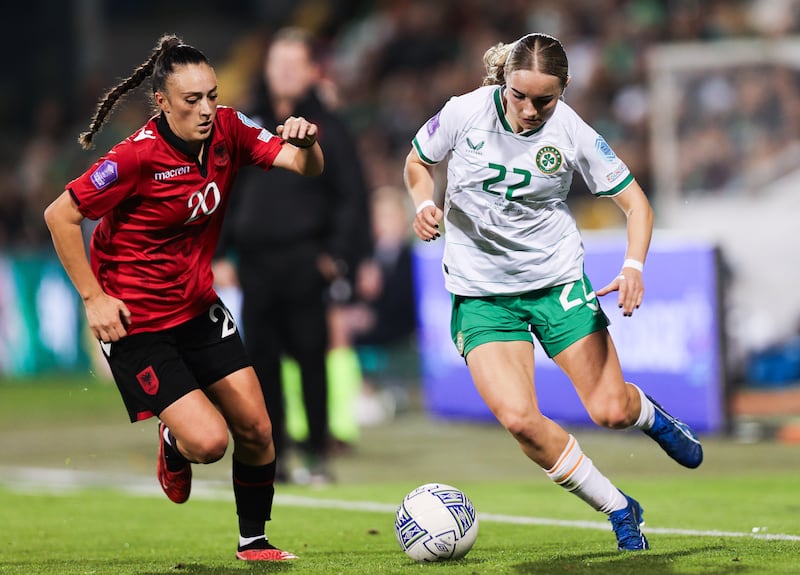It is no secret that women’s football is developing at warp speed across Europe.
The Republic of Ireland are currently making real progress but that does not guarantee survival in next year’s Nations League top tier.
The FAI are about to understand the old adage – be careful what you wish for, lest it come true – with promotion to the A division secured for 2024 after Eileen Gleeson’s side beat Albania on Tuesday night to wrap up Group B1 with two matches to spare.
No other country has been promoted yet – Finland are close – but plenty of decent teams are staring down relegation from A to B. Scotland, Wales and Switzerland have struggled to compete, with the Scots the only one of them to secure a point, having drawn with Belgium, after four rounds.
READ MORE
Results above Ireland provide a wake-up call for Gleeson, or whoever is named the permanent Irish head coach before next year’s six competitive matches against some of the best players in the game.
It poses the question, where do Ireland sit in the pecking order? Uefa ranked them 17th before the 2023/24 Nations League began and according to Fifa they sit 24th in the world, one place behind the Scots. But this list is about to undergo a major reshuffle following the October international window.
“I can’t really talk about the past because I wasn’t a part of it,” said Caitlin Hayes, the 28-year-old Celtic defender who received her Irish passport last September.
“Wherever this team wants to go, they can go. It’s great to be around new mindsets and mindsets that are aiming to get as high as they can go.
“There is no team that this team would fear,” Hayes continued. “Obviously [we] respect all, but fear none. Even in Group A there is not a team that we would take a step back against. That is a great mentality to have and it’s a great team to be a part of.
“We work hard for each other and ultimately we know what the shirt is worth, and we’ll put it all on the line for it.”
When asked how Ireland can improve before the next campaign begins in April, Hayes redirected the question to the coaching ticket of Gleeson, former Cory City manager Colin Healy, Irish goalkeeping legend Emma Byrne and Brazilian performance coach Ivi Casagrande.
“We trust the processes of the coaches, we’ve got a good coaching staff right now. They work together and it shows on the field. Obviously myself being new, there’s a lot to learn, there’s a lot to take in, there’s a lot to understand for the players that are new and I think that only gets better with time. It’s just an exciting time to support Ireland and an exciting time to be part of it.”
Clearly, pacy wing backs will remain central to the system as Gleeson enhanced the importance of Abbie Larkin, Heather Payne and Izzy Atkinson during recent victories over Albania, Hungary and Northern Ireland. Others, however, like Standard Liége duo Amber Barrett and Claire O’Riordan have slipped out of the matchday panel.

“What they need to do is just between me and them,” said Gleeson. “We have lots of competition now, football decisions will stay in the squad. We have them chats between ourselves.”
Next season’s Nations League will bring huge challenges on and off the pitch. The FAI will be tasked with filling the Aviva Stadium for the potential visit of World Cup winners Spain or European champions England.
The latter would be preferable to the former. Montserrat Tomé's all-conquering La Roja would have been forgiven for slipping up in Switzerland less than 24 hours after Barcelona were named female team of the year and Aitana Bonmatí succeeded Alexia Putellas as the Ballon d’Or winner in Paris on Monday night.
Bonmatí played 77 minutes, alongside Putellas and Jenni Hermoso, in Tuesday’s 7-1 thrashing of the Swiss.
The standard is light years above second-tier teams, like Hungary and Northern Ireland, so talk of Katie McCabe’s best position, as a second striker rather than left wing back, might be silenced by the sight of Germany, Sweden, the Netherlands or France arriving in Dublin. Expect Ireland to revert to a back five with a renewed reliance on counterattacks and the set piece.
What’s increasingly apparent from recent performances is the lack of pace in an ageing Irish defence. Albania, Hungary and Northern Ireland failed to punish them, but it’s the wave of other developing football nations that should temper expectations.
Also on Tuesday, Belgium beat England 3-2 with a rapid transitional approach that could be adopted by Irish sides when director of football Marc Canham introduces a style of play for all grades within the FAI system.
The fickleness of promotion is shown by Tessa Wullaert’s late winner for Belgium, as it pushed Sarina Wiegman’s Lionesses into the relegation conversation as third in each group must survive a playoff against Nations League B runners-up.
How about Belgium’s five defenders, three compact midfielders, a quick-thinking number 10 like Denise O’Sullivan to feed a lethal striker like McCabe or Kyra Carusa? It’s a blueprint worth studying as, on the men’s front, Canham has already referred to how Belgium developed from grassroots to the senior international team since 2000.
Point being, Ireland must take a giant leap in performance to last longer than a calendar year among the best in Europe. The immediate goal is a top-two finish, as that will secure direct qualification to Euro 2025.
“We deserve to be in Group A,” added Hayes. “We’ve worked hard for it and I can’t think of a better place for Ireland to be than in Group A and to compete with the best.”
Meanwhile, the Irish FA confirmed on Wednesday that the Republic of Ireland’s final Nations League B1 fixture against Northern Ireland will take place at Windsor Park on Tuesday, December 5th.
















